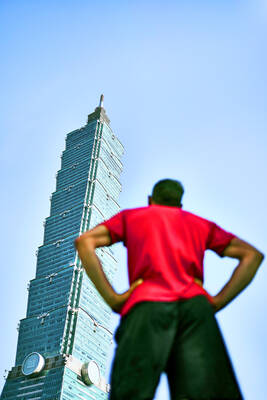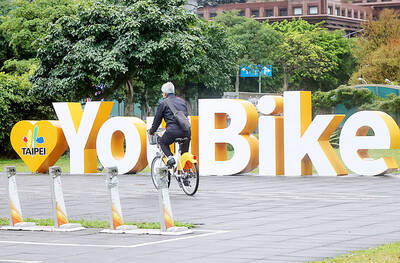The presence of Ilyushin Il-78 aerial refueling planes in the formations of Chinese People’s Liberation Army (PLA) aircraft that approached the waters off Taiwan on Wednesday and Thursday suggests not only an increase in PLA activity, but also that it is likely to simulate attack missions, political observers said.
The addition of Il-78 to the regular Xian H-6 bombers, Shaanxi Y-8 electronic-warfare aircraft and Sukhoi Su-30 fighter jets would extend the flight durations, allowing the Su-30s to escort the formation beyond the first island chain.
China has conducted long-distance navigation exercises since 2015, but the frequency has increased from several times a year to several times a month, with a record nine flypasts between July and August.
The exercises were halted during the Chinese Communist Party’s 19th National Congress last month, but have now resumed, with four flypasts this month.
In a departure from previous practice in which the bases of aircraft participating in long-distance drills was kept secret, PLA Air Force spokesman Shen Jinke (申進科) on Thursday said that multiple H-6 bombers took off from “an airbase in the Guanzhong area,” suggesting that personnel based in inland areas were also required for long-distance missions.
H-6 bombers are able to fly 6,000km, but Su-30s can only reach 3,000km, so the inclusion of the Ukrainian Ilyushin Il-78 can increase the flight distance of Su-30s, said Chieh Chung (揭仲), a senior assistant research fellow at the National Policy Foundation, a Chinese Nationalist Party (KMT)-affliated think tank.
This suggests that the Chinese air force is developing the capacity to conduct more attack exercises, observers said.
Democratic Progressive Party Legislator Tsai Shih-ying (蔡適應) said it would be difficult for Taiwan’s early warning system to detect H-6 bombers departing from bases in inland China.
Mid-air refueling capability gives PLA Air Force flight groups the ability to reach Guam, Hawaii and other locations with major US military bases, Tsai said.
The PLA is also seeking to boost coordination between military aircraft by increasing training resources and flight hours, he said, adding that Taiwan must closely monitor the situation.
With the commission of China’s second aircraft carrier, the 001A, the PLA’s “sea-bound” strategy is to stay the same, Taiwan Thinktank consultant Tung Li-wen (董立文) said, adding that it is seeking to break through the first island chain to achieve this goal.
The incorporation of the refueling aircraft not only increases the flight distance of Su-30s, but boosts the jet fighters capacity to protect naval formations and helps integrate offensive and defensive operations in the air and at sea, Tung said.
The Ministry of National Defense said the military has measures in place to protect the nation’s security.
It said it would scramble fighter jets and warships in response to approaches by PLA aircraft.

US climber Alex Honnold is to attempt to scale Taipei 101 without a rope and harness in a live Netflix special on Jan. 24, the streaming platform announced on Wednesday. Accounting for the time difference, the two-hour broadcast of Honnold’s climb, called Skyscraper Live, is to air on Jan. 23 in the US, Netflix said in a statement. Honnold, 40, was the first person ever to free solo climb the 900m El Capitan rock formation in Yosemite National Park — a feat that was recorded and later made into the 2018 documentary film Free Solo. Netflix previewed Skyscraper Live in October, after videos

Starting on Jan. 1, YouBike riders must have insurance to use the service, and a six-month trial of NT$5 coupons under certain conditions would be implemented to balance bike shortages, a joint statement from transportation departments across Taipei, New Taipei City and Taoyuan announced yesterday. The rental bike system operator said that coupons would be offered to riders to rent bikes from full stations, for riders who take out an electric-assisted bike from a full station, and for riders who return a bike to an empty station. All riders with YouBike accounts are automatically eligible for the program, and each membership account

A classified Pentagon-produced, multiyear assessment — the Overmatch brief — highlighted unreported Chinese capabilities to destroy US military assets and identified US supply chain choke points, painting a disturbing picture of waning US military might, a New York Times editorial published on Monday said. US Secretary of Defense Pete Hegseth’s comments in November last year that “we lose every time” in Pentagon-conducted war games pitting the US against China further highlighted the uncertainty about the US’ capability to intervene in the event of a Chinese invasion of Taiwan. “It shows the Pentagon’s overreliance on expensive, vulnerable weapons as adversaries field cheap, technologically

NUMBERs IMBALANCE: More than 4 million Taiwanese have visited China this year, while only about half a million Chinese have visited here Beijing has yet to respond to Taiwan’s requests for negotiation over matters related to the recovery of cross-strait tourism, the Tourism Administration said yesterday. Taiwan’s tourism authority issued the statement after Chinese-language daily the China Times reported yesterday that the government’s policy of banning group tours to China does not stop Taiwanese from visiting the country. As of October, more than 4.2 million had traveled to China this year, exceeding last year. Beijing estimated the number of Taiwanese tourists in China could reach 4.5 million this year. By contrast, only 500,000 Chinese tourists are expected in Taiwan, the report said. The report